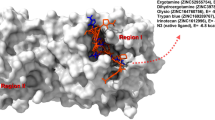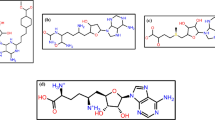Abstract
3,4,5-Trisubstituted-1,2,4-4H-triazoles (TTs) have recently been identified as a new class of potent non-nucleoside HIV-1 reverse transcriptase (RT) inhibitors. Two series of triazoles have been studied, one of which was also screened against the Y188L mutant. A computational strategy based on molecular docking studies followed by comparative molecular fields analysis (CoMFA) and comparative molecular similarity indices analysis (CoMSIA) has been used to elucidate the atomic details of the RT/TT interactions and to identify the most important features impacting the TT antiretroviral activity. Two 3D-QSAR CoMFA and CoMSIA models were derived, using the TT pEC50 values measured against wild-type (WT) HIV-1 (model A) and the Y188L mutant form (model B), respectively, as the dependent variable. The final model A CoMSIA (r 2ncv = 0.97, r 2cv = 0.89, SEE = 0.314, and r 2pred = 0.82) and model B CoMSIA (r 2ncv = 0.91, r 2cv = 0.61, SEE = 0.236, and r 2pred = 0.73) analyses were more predictive. The results allowed us to obtain useful information for the design of new compounds with improved potency towards WT HIV-1 or that are potentially active against the Y188L mutant.







Similar content being viewed by others
References
Jonckheere H, Anne J, De Clercq E (2000) The HIV-1 reverse transcription (RT) process as target for RT inhibitors. Med Res Rev 20:129–154
De Clercq E (2001) New developments in anti-HIV chemotherapy. Farmaco 56:3–12
De Clercq E (2005) Emerging anti-HIV drugs. Expert Opin Emerg Drugs 10:241–273
De Clercq E (2005) New approaches toward anti-HIV chemotherapy. E J Med Chem 48:1297–1313
Barbaro G, Scozzafava A, Mastrolorenzo A, Supuran CT (2005) Highly active antiretroviral therapy: current state of the art, new agents and their pharmacological interactions useful for improving therapeutic outcome. Curr Pharm Des 11:1805–1843
Balzarini J (2004) Current status of the non-nucleoside reverse transcriptase inhibitors of human immunodeficiency virus type 1. Curr Top Med Chem 4:921–944
De Clercq E (1998) The role of non-nucleoside reverse transcriptase inhibitors (NNRTIs) in the therapy of HIV-1 infection. Antiviral Res 38:153–179
Pedersen OS, Pedersen EB (1999) Non-nucleoside reverse transcriptase inhibitors, the NNRTI boom. Antivir Chem Chemother 10:285–314
Pedersen OS, Pedersen EB (2000) The flourishing syntheses of non-nucleoside reverse transcriptase inhibitors. Synthesis 4:479–495
Campiani G, Ramunno A, Maga G, Nacci V, Fattorusso C, Catalanotti B, Morelli E, Novellino E (2002) Non-nucleoside HIV-1 reverse transcriptase (RT) inhibitors:past, present, and future perspectives. Curr Pharm Des 8:615–657
De Clercq E (2004) Non-nucleoside reverse transcriptase inhibitors (NNRTIs): past, present, and future. Chem Biodiversity 1:44–64
Pauwels R (2004) New non-nucleoside reverse transcriptase inhibitors (NNRTIs) in development for the treatment of HIV infections. Curr Opin Pharmacol 4:437–446
Leigh Brown AJ, Frost SD, Mathews WC, Dawson K, Hellmann NS, Daar ES, Richman DD, Little SJ (2003) Transmission fitness of drug-resistant human immunodeficiency virus and the prevalence of resistance in the antiretroviral-treated population. J Infect Dis 187:683–686
Richman DD, Morton SC, Wrin T, Hellmann N, Berry S, Shapiro MF, Bozzette SA (2004) The prevalence of antiretroviral drug resistance in the United States. AIDS 18:1393–1401
De La Rosa M, Kim HW, Gunic E, Jenket C, Boyle U, Koh YH, Korboukh I, Allan M, Zhang W, Chen H, Xu W, Nilar S, Yao N, Hamatake R, Lang SA, Hong Z, Zhang Z, Girardet JL (2006) Tri-substituted triazoles as potent non-nucleoside inhibitors of the HIV-1 reverse transcriptase. Bioorg Med Chem Lett 16:4444–4449
Kirschberg TA, Balakrishnan M, Huang W, Hluhanich R, Kutty N, Liclican AC, McColl DJ, Squires NH, Lansdon EB (2007) Triazole derivatives as non-nucleoside inhibitors of HIV-1 reverse transcriptase—structure–activity relationships and crystallographic analysis. Bioorg Med Chem Lett 18:1131–1134
Chemical Computing Group Inc. (2010) MOE. Chemical Computing Group Inc., Montreal (see http://www.chemcomp.com)
Jain AN (1996) Scoring noncovalent protein-ligand interactions: a continuous differentiable function tuned to compute binding affinities. J Comput Aided-Mol Des 10:427–440
Cramer RD III, Patterson DE, Bunce JD (1989) Recent advances in comparative molecular field analysis (CoMFA). Prog Clin Biol Res 291:161–165
Klebe G, Abraham U, Mietzner T (1994) Molecular similarity indices in a comparative analysis (CoMSIA) of drug molecules to correlate and predict their biological activity. J Med Chem 37:4130–4146
Tripos Inc. (2010) Sybyl. Tripos Inc., St. Louis (see tripos.com/sybyl)
Acknowledgments
This work was financially supported by the University of Genoa. Dr. B. Domenichini is gratefully acknowledged. E.C. was financially supported by a post-doc fellowship from Area Chimica, University of Genoa.
Author information
Authors and Affiliations
Corresponding author
Electronic supplementary material
Below are the links to the electronic supplementary material.
Online Resource 1
Summary of CoMFA results for model A; summary of CoMSIA results for model A (DOC 37 kb)
Online Resource 2
Experimental and predicted pEC50 values of compounds 1, 3, 4, 6, 7, 10, 11, 13, 14, 16, 19, 22, 24–31, 33, 36, 39, 41, 45, 48–51, 53, 54, 57–60, 64–71, 77, 78, 80, 81, 84, 86–88, 90, 91, 94–96 (model A training set); experimental and predicted pEC50 values of compounds 2, 5, 8, 9, 12, 15, 17, 18, 20, 21, 23, 32, 34, 35, 37, 38, 40, 42–44, 46, 47, 52, 55, 56, 61–63, 72–76, 79, 82, 83, 85, 89, 92, 93, 97 (model A test set) (DOC 171 kb)
Online Resource 3
Model A CoMSIA hydrogen-bond acceptor polyhedra (a) and hydrogen bond donor polyhedra (b) are shown around compounds 15 (a representative of series 1 TTs, C is pink) and 83 (a representative of series 2 TTs, C is white), depicted in stick mode and colored by atom type. H-bond acceptor groups: magenta is favored; green is disfavored. H-bond donor groups: cyan is favored; purple is disfavored. Model B CoMSIA hydrogen-bond acceptor polyhedra (a) and hydrogen bond donor polyhedra (b) are shown around compounds 92, depicted in stick mode and colored by atom type. H-bond acceptor groups: magenta is favored; green is disfavored. H-bond donor groups: cyan is favored; purple is disfavored (DOC 706 kb)
Online Resource 4
Summary of CoMFA results for model B; summary of CoMSIA results for model B (DOC 112 kb)
Online Resource 5
Experimental and predicted pEC50 values of compounds 39–44, 47, 53–59, 61–64, 67, 68, 75–80, 82–92, 95 (model B training set); experimental and predicted pEC50 values of compounds 45, 46, 60, 65, 66, 81, 93, 94, 96 (model B test set) (DOC 138 kb)
Rights and permissions
About this article
Cite this article
Cichero, E., Buffa, L. & Fossa, P. 3,4,5-Trisubstituted-1,2,4-4H-triazoles as WT and Y188L mutant HIV-1 non-nucleoside reverse transcriptase inhibitors: docking-based CoMFA and CoMSIA analyses. J Mol Model 17, 1537–1550 (2011). https://doi.org/10.1007/s00894-010-0857-7
Received:
Accepted:
Published:
Issue Date:
DOI: https://doi.org/10.1007/s00894-010-0857-7




